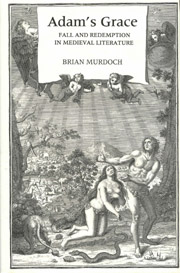Book contents
- Frontmatter
- Contents
- Ursula
- Preface
- Dedication
- Introduction: Interpreting Adam
- One After Eden: the Apocryphal Adam
- Two Written in Tablets of Stone: Adam and Gregorius
- Three Stultus et Insipiens: Adam, Parzival and the Knowledge of God
- Four Innocent Blood: Redemption and the Leper
- Five Promises to Adam: the Fall, the Redemption and Medieval Drama
- Six By the Scriptures Alone? Playing Adam in the Reformation and Beyond
- Bibliography
- Biblical Index
- General Index
Six - By the Scriptures Alone? Playing Adam in the Reformation and Beyond
Published online by Cambridge University Press: 12 September 2012
- Frontmatter
- Contents
- Ursula
- Preface
- Dedication
- Introduction: Interpreting Adam
- One After Eden: the Apocryphal Adam
- Two Written in Tablets of Stone: Adam and Gregorius
- Three Stultus et Insipiens: Adam, Parzival and the Knowledge of God
- Four Innocent Blood: Redemption and the Leper
- Five Promises to Adam: the Fall, the Redemption and Medieval Drama
- Six By the Scriptures Alone? Playing Adam in the Reformation and Beyond
- Bibliography
- Biblical Index
- General Index
Summary
WE MAY BEGIN this chapter with an unusual literary image from a period well before the Reformation. A seventh-century bishop is being addressed by a well-dressed and well-preserved anonymous, but apparently ancient, corpse found in St Paul's cathedral. When conjured to do so by Saint Erkenwald, the corpse explains that Christ had somehow neglected to redeem his soul at the time of the Harrowing. As a result the corpse has had to remain
Dwynande in þe derke deth, þat dyƷte vs oure fader,
Adam, oure alder, þat ete of þat appull,
Þat mony a plyƷtles pepul has poysned for euer. (294–6)
However, the corpse goes on to explain, Erkenwald is in far better case than he is, because although also born in guilt, Erkenwald lives sub gratia:
Ye were entouchid wyt his tethe & take in þe glotte,
Bot mended wyt a medecyne, Ʒe are made for to lyuye
Þat is fulloght in fonte, wyt faitheful bileue,
& þat han we myste alle merciles, myself & my soule. (297–300)
In fact, Erkenwald does now baptize the corpse, which promptly decays into loathsome fungus while the soul of the dead man is redeemed. The picture is a complicated one: the sinfulness of man is stressed, and original sin is clear, as indeed is the corruptible nature of the human form. Luther would have approved the imagery, for all that he referred to Legende as Lügende, legends as lying.
- Type
- Chapter
- Information
- Adam's GraceFall and Redemption in Medieval Literature, pp. 152 - 176Publisher: Boydell & BrewerPrint publication year: 2000



